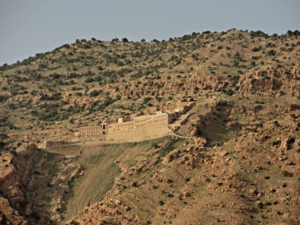Athanasius I Gammolo facts for kids
Quick facts for kids Athanasius I Gammolo |
|
|---|---|
| Syriac Orthodox Patriarch of Antioch and All the East | |
| Church | Syriac Orthodox Church |
| See | Antioch |
| Enthroned | 594/595 or 603 |
| Reign ended | 631 |
| Predecessor | Julian II |
| Successor | John III |
| Personal details | |
| Born | Samosata, Eastern Roman Empire (modern-day Samsat, Adıyaman, Turkey) |
| Died | 28 July 631 |
| Residence | Monastery of Saint Zacchaeus, Raqqa |
| Sainthood | |
| Feast day | 3 January |
| Venerated in | Syriac Orthodox Church |
Athanasius I Gammolo (Syriac: ܐܬܢܐܣܝܘܣ ܩܕܡܝܐ ܓܡܠܐ) was an important leader of the Syriac Orthodox Church. He was the Patriarch of Antioch, which means he was the head of the church, from around 594 or 603 until he passed away in 631. People remember him as a saint in the Syriac Orthodox Church, and his special day is January 3rd.
Contents
Athanasius I Gammolo's Life Story
His Early Years
Athanasius was born in the 500s in a place called Samosata. His family was wealthy. After his father died, his mother, Joanna, raised him and his brother, Severus. She gave most of their father's money to people in need, but kept enough for her sons. Athanasius and Severus got a good education. Later, they became monks at the Monastery of Qenneshre. There, they learned a lot about the Bible.
When the previous church leader, Patriarch Julian II, died, the bishops needed to choose a new one. They gathered at a monastery near Qenneshre. They prayed and fasted for three days. On the third night, they felt that the next morning, the first monk they saw passing by would be chosen by the Holy Spirit.
The next morning, the bishops saw Athanasius driving a camel. He was bringing salt from a mine to his monastery. They tested his knowledge and found out he was a monk from Qenneshre. Even though he didn't want to, he was chosen to be the new patriarch. He agreed, but asked to finish his duty of bringing salt first. This took about a year. Because of this, he became known as Gammolo, which means "camel driver" in Syriac.
Historians disagree on the exact year Athanasius became patriarch. Some say it was 603, while others say 594.
Leading the Church
Around 610 or 616, Athanasius and five bishops traveled to Alexandria in Egypt. They went because the leader of the Coptic Church, Pope Anastasius of Alexandria, wanted to improve relations. The Syriac and Coptic churches, even though they were both non-Chalcedonian (meaning they didn't agree with certain church councils), had been separated for a while.
Athanasius and his group met with Pope Anastasius at a monastery outside Alexandria. They couldn't go into the city because of rules against non-Chalcedonians. They talked about how to end the separation between their churches. Finally, they reached an agreement. They both issued a statement against the Council of Chalcedon and Leo's Tome, which were points of disagreement. After about a month, Athanasius and his group returned to Syria.
After a big war between the Roman and Sasanian empires ended in 628, Athanasius sent his secretary, John, to the Sasanian emperor. John then went to the Monastery of Saint Matthew near Nineveh. His mission was to bring together the Syriac non-Chalcedonians in both empires.
A meeting was held at the monastery, and they agreed to reunite. John returned to Athanasius with several bishops and monks from the east. Athanasius allowed the eastern churches to choose their own bishops. He also made a monk named Marutha the main bishop of Tagrit, giving him authority over all bishops in the Sasanian Empire. In 629, Athanasius sent a letter confirming the Monastery of Saint Matthew's importance. Its bishop was given special titles and became the head bishop for Assyria.
Later Years and Death
In 629, the Emperor Heraclius called Athanasius to a meeting in Mabbogh, Syria. The emperor wanted to solve the differences between his Chalcedonian church and Athanasius's non-Chalcedonian Syriac Orthodox Church.
Athanasius and several bishops met with the emperor and debated for twelve days. Heraclius wanted them to accept a certain belief, but Athanasius and his bishops refused. The emperor became very angry and ordered that non-Chalcedonians in the empire be treated badly.
Athanasius passed away on July 28, 631. He was buried at the Monastery of the Garoumaye.
His Contributions
Athanasius played a role in creating important religious texts. He asked Paul of Tella to translate the Old Testament into Syriac, which was done between 615 and 617. This translation is known as the Syro-Hexapla.
He also might have supported other translations, like Paul of Edessa's Syriac translation of the Homilies by Gregory of Nazianzus. Another important work he supported was the Harklean version of the New Testament, translated by Thomas of Mabbogh.
Athanasius also wrote a book about the life of Patriarch Severus of Antioch. The original book is lost, but parts of it exist in Coptic and Arabic copies.


